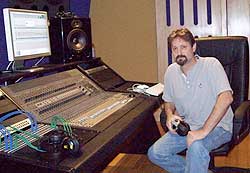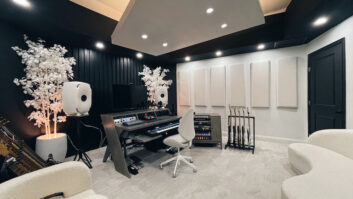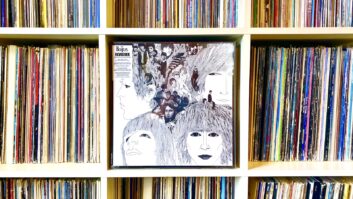
Eric Heil of Atlanta’s Angelic Productions/The Loft
Think back to your favorite live album. You know, the one that was recorded a few decades ago but just never seems dated. There’s something really special about the way it makes you feel, right? It transports you to another place for a few minutes and gives off that “you’re right there” kind of vibe.
While audiences still love the live album feel, thanks to technology, their expectations about what they want to hear are not what they used to be. These expectations, as well as the marked changes in the music industry, have contributed to significant shifts in what is expected of remote recording professionals. These shifts are not only forcing small to mid-sized outfits to develop new approaches, but to also wear multiple hats. Read on to find out how three remote recording specialists from opposite sides of the country are adapting.
CHANGING EXPECTATIONS, CHANGING PERCEPTION
Considering that every one of us who listens to radio has been, in a sense, brainwashed to expect sonic perfection, the expectations placed on today’s artists and bands are higher than ever before. If you think of some of the greatest tunes recorded 20 or 30 years ago, you have to admit that there were sound quality issues and the vocals were sometimes less than pitch-perfect. But nobody was protesting. In fact, it gave the recordings character and a sense of authenticity. Well, today, according to the live recording professionals we spoke with, authenticity has taken a back seat to flawlessness, with few exceptions. “Now, when bands record live, they’re not content with the quality that is produced authentically; they want to go in and change the way things sound, whereas before they were happy to just go to tape,” says Donald Setaro, a Modesto, Calif.–based live recording specialist who records everything from bands and singer/songwriters, to orchestras and church performances and has aptly been dubbed The Recording Guy.
Setaro, who’s been in the business since the 1970s, has seen a dramatic shift in the trend toward perfection. “When I first started out, we used big consoles and tape machines—sometimes 2- or 4-tracks—and we would mix right then and there while the artist or band was onstage, and we’d work with whatever we captured from the P.A. into the splitter,” he recalls. But today’s bands expect more. They expect to create a sound that is similar to what they are used to hearing on the radio. Fortunately, Setaro can accommodate. He uses a variety of equipment to capture sound, including a Tascam X-48 digital recorder, PreSonus Digimax 8-channel preamps, dbx 166XL compressors, a Whirlwind 48-channel splitter with isolated outputs and Mass W4 connectors, as well as multiple microphones, including AKG, Countryman, Shure and Neumann models. But it’s the process that follows collection that Setaro says many clients ultimately request.
“We’re able to enhance live recordings using tools like Sound Replacer and Drumagog. In fact, I used some of these tools for a performance by singer/songwriter Dirk Hamilton that I recently recorded. His producer/bassist, Eric Westphal, wasn’t happy with the sound of the kick drum, so I went in and used sampled replacements. Fortunately, Eric didn’t want to lose the live performance feel of the recording, so we didn’t go too far beyond that.”
While making fixes in the studio after a live recording is standard practice, the process itself has undergone some serious alterations. “When I first started doing live recording in 2003, we would do the recording—usually at a big venue—and get paid pretty well to see the project all the way through,” says Allen Kyle, the owner of Austin, Texas’ Night Owl Recording, which specializes in live and remote recording. His one-man remote outfit operates from recorders and preamps that are all racked up, patched in and ready to go. He simply uncases on-site, plugs the runs from his splitter to the preamps, plugs the tape returns into the mixer and checks the clock. In the past, it wouldn’t end there.
“Typically, I would choose a recording studio to use for taking care of overdubs and preparing a final mix. In those days, one night of recording would translate into one month of work, but that’s not the case anymore.” In fact, it’s been almost a year since Kyle has taken a recording project from beginning to end. The reason: the proliferation of home studios. As they’ve become more and more popular, the demand for “mid-end” mixing services has diminished.
“The clients I work with nowadays just want their tracks recorded. What that means for me is that I’ll do weeks of planning, research, talking to venues and clients, I get one shot to do the recording and then I never see the project again. I won’t lie; it’s pretty frustrating,” admits Kyle, whose gear includes Mackie HDR 24-bit hard disk recorders, SDR 24-track recorders and 24 tracks of independent backup, along with a 24-channel customer two-way transformer and an isolated mic splitter.
What’s even more frustrating is the fact that, with budgets as tight as they are, many acts aren’t seeking out live recording engineers in the first place. “I’ve got to try to convince bands a lot of the time about the value of me recording their live shows,” says Eric Heil of Atlanta’s Angelic Productions/The Loft, which provides mobile recording services and concert productions for clients. Heil, who uses 48-input Pro Tools HD and dual computer monitors with two Midas 320 consoles and a Whirlwind 48×8 isolation split, says good equipment is not enough. Rather, he reaches potential clients through social networking. Allen also creates buzz about his mobile recording services to woo bands. He researches which ones are coming into town, determines which venues would be good for them to record in and then reaches out.
“I pick up the phone and give them a call, tell them who I’ve recorded, and explain that I know what I’m doing and can give them a great rate for great sound,” says Kyle, who admits that while most bands express an interest, only 10 to 20 percent of them actually have the money to move forward and, as a result, half of his business is made up of corporate clients.
Sometimes, it even comes down to doing the work with no guarantees. “There have been occasions in which I’ve recorded a band with the notion that if they like it, great, and if they don’t, we’ll just part as friends,” adds Setaro. “The key is showing people what I can do so they can hear the great sound quality, the separation of the instruments and how the tracks end up. I also show them how I’m able to do my job without interfering with the crew. It really comes down to educating them.”
Allen Kyle, the owner of Austin, Texas’ Night Owl Recording
SHIFTING FROM EDUCATOR TO STUDENT
In fact, in light of the drastic changes in the music industry during the past decade, educating clients has become one of the most formidable tools in the success of live sound recording professionals. “I find myself preaching the word about artists taking control of their own careers on a regular basis,” says Heil, who records bands and recording artists in the rock, country and contemporary Christian genres. “Many of them are still convinced that the big labels are going to ‘discover’ them and put them on tour with tour support and pay for their album projects. I try to help them understand that it doesn’t work that way anymore. If you’re an artist today, you’ve got to produce your own record and create your own product and then go to the record companies with some evidence that will make them believe it will sell and make them some money.”
In addition, live recording professionals often bear the burden of educating clients about the benefits of professional recording and convince them they shouldn’t do it themselves just because they may have the equipment at their disposal. “My biggest selling point is that I don’t just have professional equipment, but also the expertise and the experience that the $10-an-hour guys doesn’t,” says Heil. “I can, quite simply, create sound that they can’t, but I’m still not like a big house that will charge $2,000 a day.”
When it comes to education, it’s a two-way street. According to Setaro, it’s important that live recording professionals take plenty of time to educate themselves about the client, the client’s goals and the venue so they can create an effective plan. For an upcoming recording of an Assyrian orchestra, for instance, Setaro is gathering information and planning a month out. “The performance will feature a symphony orchestra, pop singers and then solo instrumental pieces. It’s a big undertaking that will take all 48 tracks so I’ve really got to get a solid plan together for it.” In addition to hiring another live sound professional to work with him on the day of the performance, Setaro has conducted thorough interviews with his client to get a handle on the specific details of the show, such as who’s in charge of production; how many cellos, violins, timpani, etc. will be involved; how the stage will be set up; and other details that will help him capture sound most effectively. “I’ve got to consider things like the amount and type of mics and equipment I’m going to need, where I’m going to obtain this equipment and how my setup is going to work with my client’s stage,” he says. In this case, it will be a challenge because the client’s goal is to have a visually stunning stage, which is going to require Setaro to come up with alternate ways of running cables and placing mic stands so that the view of the players is not obstructed.
This is a situation that Setaro has grown accustomed to, and he says, in fact, that one of the most important parts of his job is capturing the “live” performance of his clients while remaining unnoticed. “Most of the time, I set up on the side of the stage by the monitor mixer or somewhere out of the way but in a place I can see the performance and be close to the stage,” says Setaro, whose band clients typically use the audio he’s captured for promotional purposes, while his church clients use it for archive and training purposes.
Kyle sets himself up in a closet, outside behind the stage, or “whatever place I can find that’s out of the way and quiet,” though he confesses that that’s a tall order in a club environment. Needless to say, his setup is largely determined by the venue. In a small venue, the splitter is placed on the stage near the house snake and all inputs will go to the splitter first. Then, one trunk will go short to the house snake and the other trunk will go to him. In a large venue, on the other hand, the stage plumbing will usually involve subsnakes to a main box onstage that travels on to the monitor world. In this case, “I generally set up near the monitor guy, and one side will go to me and the other will continue to my distribution system,” explains Kyle.
While Heil prefers setting up his gear in an isolated room within the venue to stay hidden, sometimes he’s had to set up shop right onstage next to the monitor console. “Sometimes, if it’s a really tight budget, I will forgo the consoles and split and tap the direct outs of the monitor console, but that configuration creates more work on the back end and either I or the band’s engineer end up doing a lot more ‘fix it in the mix,’ so that’s not my favorite option,” says Heil, who also does a “live mix to cameras” out of Pro Tools setup using buses and secondary outputs. In this scenario, he will mix the show live and send that out to the DVRs, and either generate or receive LTC and stripe that to the session for frame-accurate audio in post. “I take the camera two-mix and stripe that to a stereo track alongside the multitrack. If the client needs reference tracks, I can cut the two-mix up into regions and export the regions as files, then burn that to CD or DVD. It all depends on what the client wants.”
One thing most clients want in a live recording situation is crowd sound, so it’s critical for remote recording professionals to calculate the size of the stage and the distance to the crowd to properly capture audience sound. According to Kyle, one of the most important aspects of a successful live recording is the live audience sound element. That said, positioning mics to capture the crowd and mixing this sound well are the secret glue that holds a live recording together. “You may hear folks kicking stuff and all kinds of extraneous noises going on, but if the crowd sound is mixed well, you can hide a lot of problems,” says Kyle. “The bottom line is, if the glue isn’t a good, high-quality sticky glue but a crusty old glue stick from 1996, the sound isn’t going to come together and you’re not going to accomplish the good, live sound feel you were shooting for.”
Glue aside, it’s important for remote recording professionals to realize that, at the end of the day, the live recording is going to sound like the venue in which it was recorded, regardless of how great the band is or how well the sound is captured. “I’ve recorded bands in venues with tin roofs on 10-foot-deep stages where the band wouldn’t play unless their monitors measured 120dB SPL onstage—actually louder than the P.A.—with a lead vocal mic that is just getting nailed with cymbals, drum wash and monitor bleed. And then I’ve recorded in large concert halls that have grand ceilings, wood floors and amazing acoustics,” says Kyle. “What I’m going to be able to capture is going to depend on where I am. A lot of times, it doesn’t even matter what mics or preamps I’ve got. It’s all about the location.”
Donald Setaro
STAYING IN THE GAME
Well, it’s almost all about the location. For live recording specialists, just like other recording professionals, it’s also about building relationships. No matter what the specific circumstances of a given job are, Setaro always tries to find a way to leave on a good note. “Even if the crew has been horrible and things were shaky, I always make a serious attempt to part as friends,” says Setaro. “Ultimately, these guys need to be my buddies. My relationship with them may be the determining factor on whether I get the next job that they’re involved with.” Beyond the crew, Setaro also stresses the importance of being friendly with other live sound companies and recording studios because there just may be situations in which they are going to have to work together. “There’s nothing bad that can come from me developing a good relationship with these guys. They may throw things my way, I may throw things their way. It’s a lot of give and take.”
And those relationships may play an increasingly important role down the road, as technology continues to get smaller, more affordable and more accessible to non-professionals. “I get questions from would-be clients like, ‘Can you record 10 to 12 songs for my album in one day and for like $100?'” says Heil. “There’s not a whole lot of understanding out there about what really goes into the process. Unfortunately, American society is about instant gratification. These are factors that I believe may work against our profession in the future.”
The saving grace may wind up being what many hold responsible for the death of (or at least, the severe maiming of) the old music industry: the Internet. “There’s a whole new level of distribution available to bands and artists thanks to the Internet,” says Kyle. “Bands no longer have to go to a million-dollar recording studio or venue to record their project or their show to come out with material that they’re proud of, and the Internet, of course, decreases the sonic requirements even more. The good news for remote recording professionals is that the Internet hasn’t just created an effective way of promoting our services, but it has also opened up a whole new market for clients and that can only benefit us.”
Studio Unknown is full-service audio post production facility and recording studio that specializes in helping clients discover creative sound for film, video, web, gaming, and artist projects. For more information, visit www.studiounknown.com.




